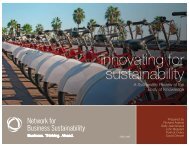embedding sustainability in organizational culture - Network for ...
embedding sustainability in organizational culture - Network for ...
embedding sustainability in organizational culture - Network for ...
You also want an ePaper? Increase the reach of your titles
YUMPU automatically turns print PDFs into web optimized ePapers that Google loves.
Chapter 1: 6: Introduction Instill<strong>in</strong>g Capacity <strong>for</strong> Change<br />
50<br />
• Implement <strong>for</strong>mal feedback systems<br />
• Institutionalize time <strong>for</strong> reflection<br />
Several practitioners mentioned the importance of reflect<strong>in</strong>g on what the<br />
organization is do<strong>in</strong>g, as part of the learn<strong>in</strong>g process, along with the need to create<br />
regular opportunities to reflect (NBS, 2010).<br />
Doppelt (2008) notes that one step backward, to reflect, can be very reveal<strong>in</strong>g and<br />
result <strong>in</strong> two steps <strong>for</strong>ward. Through regular assessments and feedback mechanisms<br />
an organization can beg<strong>in</strong> to <strong>for</strong>malize and <strong>in</strong>stitutionalize its process of reflection<br />
(Dunphy et al., 2003).<br />
We found no empirical work that explored whether reflect<strong>in</strong>g is a practice that can<br />
support a <strong>culture</strong> of <strong>susta<strong>in</strong>ability</strong>.<br />
assessment: proposed but not tested<br />
develop<br />
This category looks at practices that create or implement new mechanisms to<br />
support future <strong>susta<strong>in</strong>ability</strong> <strong>in</strong>itiatives. These practices <strong>in</strong>clude putt<strong>in</strong>g <strong>in</strong> place new<br />
and <strong>in</strong>novative systems and procedures (<strong>in</strong>ternal) and also products and services<br />
(external) as a foundation <strong>for</strong> future <strong>susta<strong>in</strong>ability</strong> <strong>in</strong>itiatives.<br />
dEvElop nEw BuS<strong>in</strong>ESS pRocESSES and SyStEMS: implement new<br />
<strong>in</strong>ternal procedures and/or systems that will support <strong>susta<strong>in</strong>ability</strong><br />
• Implement new environmental management systems (EMS) or a<br />
<strong>susta<strong>in</strong>ability</strong> management system (SMS)<br />
• Develop new decision support systems based on <strong>susta<strong>in</strong>ability</strong><br />
factors<br />
Researchers have proposed that design<strong>in</strong>g a Susta<strong>in</strong>ability Management System<br />
(SMS) may be an effective way to implement <strong>susta<strong>in</strong>ability</strong> (Esquer-Peralta et<br />
al., 2008; Holton et al., 2010). Esquer-Peralta et al. (2008) recommend br<strong>in</strong>g<strong>in</strong>g<br />
exist<strong>in</strong>g systems together under one new Susta<strong>in</strong>ability Management System (SMS).<br />
Based on this prelim<strong>in</strong>ary research, further research is required to understand the<br />
impact of develop<strong>in</strong>g new processes and management systems and more specifically,<br />
what impact these systems may have on the organization’s <strong>culture</strong>.<br />
assessment: Weakly supported<br />
dEvElop nEw pRoductS and SERvicES: create new product or services<br />
that realize the organization’s commitment to <strong>susta<strong>in</strong>ability</strong><br />
• Develop new products and services with m<strong>in</strong>imal negative impacts<br />
on the natural environment<br />
• Develop new products and services that meet unmet <strong>susta<strong>in</strong>ability</strong><br />
needs<br />
In the quadrant on clarify<strong>in</strong>g expectations, we looked at how organizations can<br />
<strong>in</strong>tegrate and respond to <strong>susta<strong>in</strong>ability</strong> criteria <strong>in</strong> exist<strong>in</strong>g product designs and life<br />
cycles. We now look at how organizations can develop entirely new products and<br />
services to signal their commitment to the environment and their ability to stay<br />
relevant <strong>in</strong> the future.<br />
Ethical Corporation (2009) proposes that the best way that production departments<br />
can embed <strong>susta<strong>in</strong>ability</strong> is through creat<strong>in</strong>g products that address societal or<br />
environmental needs. Smith and Brown (2003) found that when an organization<br />
developed new susta<strong>in</strong>able products <strong>in</strong> l<strong>in</strong>e with its espoused values, this built<br />
employee pride and confidence <strong>in</strong> the organization’s mission and its leaders. At<br />
Interface, a new generation of products that took a complete life-cycle approach sent<br />
a strong signal to employees that the organization had set new priorities (DuBose,<br />
2000).<br />
Much more research is needed to understand the impact that develop<strong>in</strong>g new<br />
susta<strong>in</strong>able products and services has on how employees view their organization.<br />
assessment: Weakly supported
















